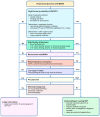A Narrative Review on the Approach to Antimicrobial Use in Ventilated Patients with Multidrug Resistant Organisms in Respiratory Samples-To Treat or Not to Treat? That Is the Question
- PMID: 35453203
- PMCID: PMC9031060
- DOI: 10.3390/antibiotics11040452
A Narrative Review on the Approach to Antimicrobial Use in Ventilated Patients with Multidrug Resistant Organisms in Respiratory Samples-To Treat or Not to Treat? That Is the Question
Abstract
Multidrug resistant organisms (MDRO) are commonly isolated in respiratory specimens taken from mechanically ventilated patients. The purpose of this narrative review is to discuss the approach to antimicrobial prescription in ventilated patients who have grown a new MDRO isolate in their respiratory specimen. A MEDLINE and PubMed literature search using keywords "multidrug resistant organisms", "ventilator-associated pneumonia" and "decision making", "treatment" or "strategy" was used to identify 329 references as background for this review. Lack of universally accepted diagnostic criteria for ventilator-associated pneumonia, or ventilator-associated tracheobronchitis complicates treatment decisions. Consideration of the clinical context including signs of respiratory infection or deterioration in respiratory or other organ function is essential. The higher the quality of respiratory specimens or the presence of bacteremia would suggest the MDRO is a true pathogen, rather than colonization, and warrants antimicrobial therapy. A patient with higher severity of illness has lower safety margins and may require initiation of antimicrobial therapy until an alternative diagnosis is established. A structured approach to the decision to treat with antimicrobial therapy is proposed.
Keywords: ICU; decision; multidrug resistant; treatment; ventilator associated pneumonia; ventilator associated tracheobronchitis.
Conflict of interest statement
The authors declare no conflict of interest.
Figures


Similar articles
-
Incidence and prognosis of ventilator-associated tracheobronchitis (TAVeM): a multicentre, prospective, observational study.Lancet Respir Med. 2015 Nov;3(11):859-68. doi: 10.1016/S2213-2600(15)00326-4. Epub 2015 Oct 22. Lancet Respir Med. 2015. PMID: 26472037
-
Use of nebulized antimicrobials for the treatment of respiratory infections in invasively mechanically ventilated adults: a position paper from the European Society of Clinical Microbiology and Infectious Diseases.Clin Microbiol Infect. 2017 Sep;23(9):629-639. doi: 10.1016/j.cmi.2017.04.011. Epub 2017 Apr 13. Clin Microbiol Infect. 2017. PMID: 28412382
-
Key considerations on nebulization of antimicrobial agents to mechanically ventilated patients.Clin Microbiol Infect. 2017 Sep;23(9):640-646. doi: 10.1016/j.cmi.2017.03.018. Epub 2017 Mar 25. Clin Microbiol Infect. 2017. PMID: 28347790
-
Should We Treat Ventilator-Associated Tracheobronchitis with Antibiotics?Semin Respir Crit Care Med. 2017 Jun;38(3):264-270. doi: 10.1055/s-0037-1602582. Epub 2017 Jun 4. Semin Respir Crit Care Med. 2017. PMID: 28578551 Review.
-
Host-pathogen interaction during mechanical ventilation: systemic or compartmentalized response?Crit Care. 2019 Jun 14;23(Suppl 1):134. doi: 10.1186/s13054-019-2410-0. Crit Care. 2019. PMID: 31200727 Free PMC article. Review.
Cited by
-
Innovative Solutions for Multidrug-Resistant Organisms' Infections in Intensive Care Unit: A Joint Efficacy Evaluation of Multidisciplinary Team and SHEL (Software, Hardware, Environment, Liveware) Model.Curr Ther Res Clin Exp. 2024 Dec 3;102:100766. doi: 10.1016/j.curtheres.2024.100766. eCollection 2025. Curr Ther Res Clin Exp. 2024. PMID: 39816493 Free PMC article.
-
Pathogen Burden Among ICU Patients in a Tertiary Care Hospital in Hail Saudi Arabia with Particular Reference to β-Lactamases Profile.Infect Drug Resist. 2023 Feb 5;16:769-778. doi: 10.2147/IDR.S394777. eCollection 2023. Infect Drug Resist. 2023. PMID: 36779043 Free PMC article.
-
SPECT Imaging of P. aeruginosa Infection in Mice Using 123I-BMIPP.Pharmaceutics. 2024 May 14;16(5):656. doi: 10.3390/pharmaceutics16050656. Pharmaceutics. 2024. PMID: 38794318 Free PMC article.
References
-
- Nseir S., Di Pompeo C., Pronnier P., Beague S., Onimus T., Saulnier F., Grandbastien B., Mathieu D., Delvallez-Roussel M., Durocher A. Nosocomial tracheobronchitis in mechanically ventilated patients: Incidence, aetiology and outcome. Eur. Respir. J. 2002;20:1483–1489. doi: 10.1183/09031936.02.00012902. - DOI - PubMed
-
- Luckraz H., Manga N., Senanayake E.L., Abdelaziz M., Gopal S., Charman S.C., Giri R., Oppong R., Andronis L. Cost of treating ventilator-associated pneumonia post cardiac surgery in the National Health Service: Results from a propensity-matched cohort study. J. Intensive Care Soc. 2018;19:94–100. doi: 10.1177/1751143717740804. - DOI - PMC - PubMed
-
- Melsen W.G., Rovers M.M., Groenwold R.H., Bergmans D.C., Camus C., Bauer T.T., Hanisch E.W., Klarin B., Koeman M., Krueger W.A., et al. Attributable mortality of ventilator-associated pneumonia: A meta-analysis of individual patient data from randomised prevention studies. Lancet Infect. Dis. 2013;13:665–671. doi: 10.1016/S1473-3099(13)70081-1. - DOI - PubMed
Publication types
LinkOut - more resources
Full Text Sources

